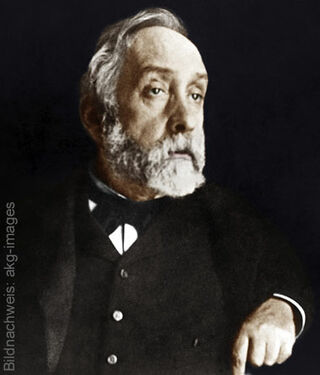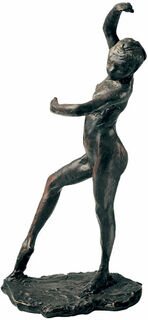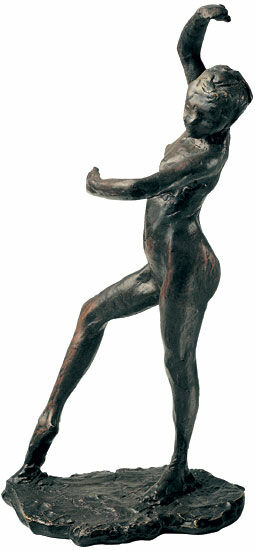Sculpture "Spanish Dancer", bronze version
Sculpture "Spanish Dancer", bronze version
Quick info
ars mundi Exclusive Edition | bronze | handmade | size 13 x 45 x 19 cm (w/h/d) | weight approx. 4 kg
Detailed description
Sculpture "Spanish Dancer", bronze version
Degas became increasingly blind as he aged, making it impossible to paint. But his creative power remained unshaken. He, therefore, gradually concentrated on small sculptures, which also established his eternal reputation as a sculptor. The "Spanish Dancer" was first cast by Hébrand in 1900.
Original: Bronze, between 1882-1900, Musée d'Orsay, Paris.
Sculpture made of fine bronze, cast by hand using the Lost-Wax-Process. Size 13 x 45 x 19 cm (w/h/d). Weight approx. 4 kg. ars mundi Exclusive Edition.

About Edgar Degas
1834-1917
Pictures of graceful dancers and colourful theatre scenes have been at the centre of Degas' work since the mid-1860s. They belong to everyday pictures depicting metropolitan life. In many of his paintings, Degas criticises the new modern world. He selected a rather unusual detail that had caught his attention and emphasised it through the isolation of the individual.
Born in 1834, the French painter, who according to the wishes of his wealthy family should actually have become a lawyer, had studied the art of old masters in the Louvre and the museums of Italy. Classicist history paintings and portraits were part of his repertoire of motifs and forms at that time. Only his encounter and regular exhibitions with the Impressionist Eduard Manet starting in 1874 changed his painting style. However, he never saw himself as a representative of Impressionism and insisted on his independence.
There are no landscapes in his oeuvre, nor did he work with the Impressionist dissection of colour and form. For Degas, the human being was always the dominant theme of his work. The link between his works and those of the Impressionists lay in the endeavour to capture the moment. He proved his skill in depicting movement in his dynamic paintings of horse races and ballet scenes. He also captured his subject through rapid brushwork of pastel colours and delicate contour lines. Degas' artistic basis was drawing, which was inspired by the Japanese woodcut. Equally important, he translated the subject matter into painting as well as graphic art.
As Degas' slowly lost his eyesight towards the end of his life, he switched from painting to sculpture. He modelled statuettes of horsemen and dancers, thus remaining true to his familiar motifs. Degas died in Paris in 1917.
An alloy of copper with other metals (especially with tin) used since ancient times.
When casting bronze, the artist usually applies the lost-wax technique which is dating back more than 5000 years. It's the best, but also the most complex method of producing sculptures.
First, the artist forms a model of his sculpture. It is embedded in a liquid silicone rubber mass. Once the material has solidified, the model is cut out. The liquid wax is poured into the negative mould. After cooling down, the wax cast is removed from the mould, provided with sprues and dipped into ceramic mass. The ceramic mass is hardened in a kiln, whereby the wax flows out (lost mould).
Now we finally have the negative form, into which the 1400° C hot molten bronze is poured. After the bronze had cooled down, the ceramic shell is broken off and the sculpture is revealed.
Now the sprues are removed, the surfaces are polished, patinated and numbered by the artist himself or, to his specifications, by a specialist. Thus, each casting becomes an original work.
For lower-quality bronze castings, the sand casting method is often used which, however, does not achieve the results of a more complex lost-wax technique in terms of surface characteristics and quality.
Graphic or sculpture edition that was initiated by ars mundi and is available only at ars mundi or at distribution partners licensed by ars mundi.
The style of Impressionism, which emerged in French painting around 1870, owes its name to Claude Monet's landscape 'Impression, Soleil Levant'. After initial rejection, it began a veritable triumphal procession.
Painters such as Claude Monet, Edgar Degas, Edouard Manet, Auguste Renoir and others created motifs from everyday life, urban and landscape scenes in bright, natural light.
Impressionism can be seen as a reaction to academic painting. The emphasis was not on content with its strict rules of painting structure, but on the object as it appears at any given moment, in an often random cut out. The reality was seen in all its variety of colours in natural lighting. The Studio painting was replaced by open-air painting.
Through the brightening of the palette and the dissolution of firm contours, a new approach to colour emerged. In many cases, the colours were no longer mixed on the palette but side by side on the canvas so that the final impression lies in the eye of the viewer with a certain distance. In "Pointillism", (with painters such as Georges Seurat or Paul Signac) this principle was taken to the extreme.
Outside France, Impressionism was taken up by painters such as Max Slevogt, Max Liebermann and Lovis Corinth in Germany, and by James A. M. Whistler in the United States.
However, Impressionism was only expressed to a limited extent in the art of sculpture. In the works of Auguste Rodin, who is considered one of the main representatives, a dissolution of surfaces is evident, in which the play of light and shadow is included in the artistic expression. Degas and Renoir created sculptures as well.
A true-to-the-original reproduction of an artwork in the same size and with the best possible material and colour uniformity.
The mould is usually taken directly from the original so that the replication reproduces even the finest details. After casting the replication, using the most appropriate method, the surface is polished, patinated, gilded or painted according to the original.
A replication of ars mundi is a recognizable copy of the original.
A plastic work of sculptural art made of wood, stone, ivory, bronze or other metals.
While sculptures from wood, ivory or stone are made directly from the block of material, in bronze casting a working model is prepared at first. Usually, it is made of clay or other easily mouldable materials.
The prime time of sculpture after the Greek and Roman antiquity was the Renaissance. Impressionism gave a new impulse to the sculptural arts. Contemporary artists such as Jorg Immendorf, Andora, and Markus Lupertz also enriched sculptures with outstanding works.


